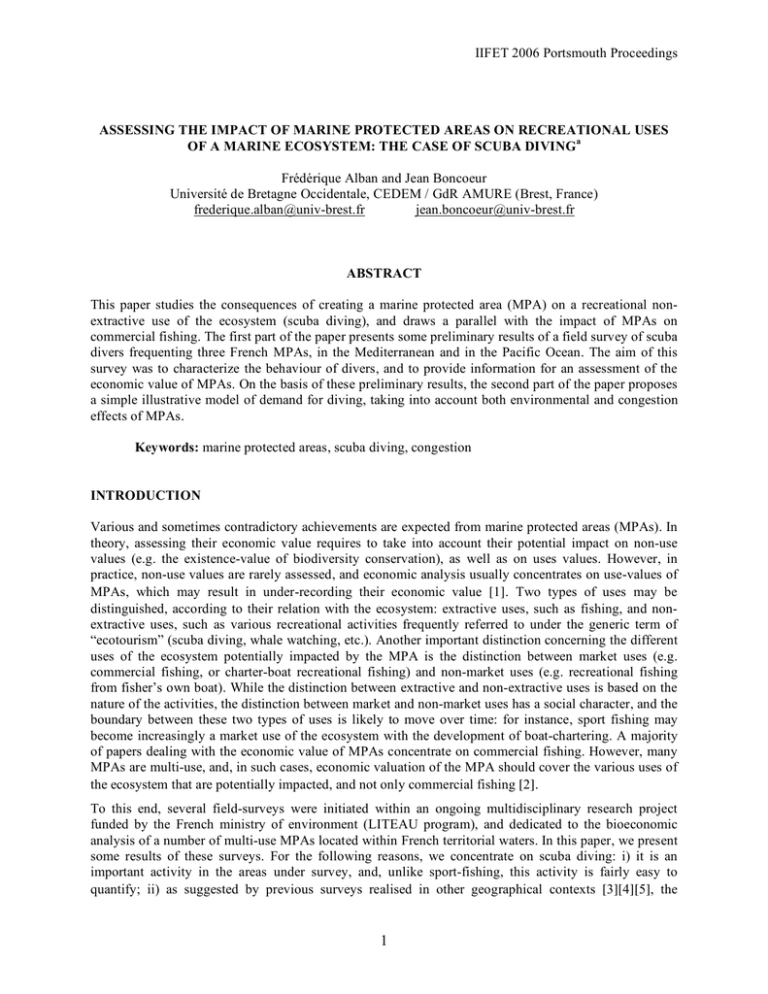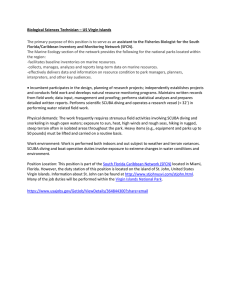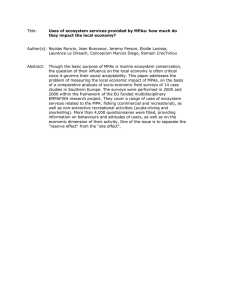IIFET 2006 Portsmouth Proceedings
advertisement

IIFET 2006 Portsmouth Proceedings ASSESSING THE IMPACT OF MARINE PROTECTED AREAS ON RECREATIONAL USES OF A MARINE ECOSYSTEM: THE CASE OF SCUBA DIVINGa Frédérique Alban and Jean Boncoeur Université de Bretagne Occidentale, CEDEM / GdR AMURE (Brest, France) frederique.alban@univ-brest.fr jean.boncoeur@univ-brest.fr ABSTRACT This paper studies the consequences of creating a marine protected area (MPA) on a recreational nonextractive use of the ecosystem (scuba diving), and draws a parallel with the impact of MPAs on commercial fishing. The first part of the paper presents some preliminary results of a field survey of scuba divers frequenting three French MPAs, in the Mediterranean and in the Pacific Ocean. The aim of this survey was to characterize the behaviour of divers, and to provide information for an assessment of the economic value of MPAs. On the basis of these preliminary results, the second part of the paper proposes a simple illustrative model of demand for diving, taking into account both environmental and congestion effects of MPAs. Keywords: marine protected areas, scuba diving, congestion INTRODUCTION Various and sometimes contradictory achievements are expected from marine protected areas (MPAs). In theory, assessing their economic value requires to take into account their potential impact on non-use values (e.g. the existence-value of biodiversity conservation), as well as on uses values. However, in practice, non-use values are rarely assessed, and economic analysis usually concentrates on use-values of MPAs, which may result in under-recording their economic value [1]. Two types of uses may be distinguished, according to their relation with the ecosystem: extractive uses, such as fishing, and nonextractive uses, such as various recreational activities frequently referred to under the generic term of “ecotourism” (scuba diving, whale watching, etc.). Another important distinction concerning the different uses of the ecosystem potentially impacted by the MPA is the distinction between market uses (e.g. commercial fishing, or charter-boat recreational fishing) and non-market uses (e.g. recreational fishing from fisher’s own boat). While the distinction between extractive and non-extractive uses is based on the nature of the activities, the distinction between market and non-market uses has a social character, and the boundary between these two types of uses is likely to move over time: for instance, sport fishing may become increasingly a market use of the ecosystem with the development of boat-chartering. A majority of papers dealing with the economic value of MPAs concentrate on commercial fishing. However, many MPAs are multi-use, and, in such cases, economic valuation of the MPA should cover the various uses of the ecosystem that are potentially impacted, and not only commercial fishing [2]. To this end, several field-surveys were initiated within an ongoing multidisciplinary research project funded by the French ministry of environment (LITEAU program), and dedicated to the bioeconomic analysis of a number of multi-use MPAs located within French territorial waters. In this paper, we present some results of these surveys. For the following reasons, we concentrate on scuba diving: i) it is an important activity in the areas under survey, and, unlike sport-fishing, this activity is fairly easy to quantify; ii) as suggested by previous surveys realised in other geographical contexts [3][4][5], the 1 IIFET 2006 Portsmouth Proceedings demand for this activity is likely to be significantly influenced by the existence of a MPA; iii) empirical evidence concerning this influence is easier to provide than in the case of fishing, because it does not rely critically on fish biomass transfers between the no-take zone (NTZ) and the zone that is left open to fishing. The first part of the paper presents some preliminary results of a field survey concerning scuba diving in three MPAs covered by the project. The aim of this survey was to characterize the behaviour of divers and to provide information for an assessment of the economic value of the MPA. On the basis of these preliminary results, the second part proposes a simple illustrative model of demand for diving. FIELD SURVEYS Table I compares scuba diving to commercial fishing, which is, among the various anthropic activities impacted by MPAs, the most widely analysed by the literature. Table I. Two activities impacted by MPAs: a brief comparison Type of activity Commercial fishing Scuba diving Yes No, but possible impact on ecosystem Yes Yes, most of the time (diving operators). But price paid to operators is only part of total cost for the user. Usually exogenous (market much larger than local supply) Probably endogenous (monopolistic competition) Main impact of MPA on activity? Shift in supply curve Shift in demand curve Major task for economic assessment? Change in producers surplus Change in consumers surplus Extractive activity ? Market activity? Price determination? The most obvious difference between these two activities is due to the “non extractive” character of scuba diving (which does not imply that it has no impact on marine ecosystems). As a result, they are likely to be differently impacted by the creation of a MPA: while the increase in fish abundance inside the NTZ (if any) is expected to benefit fishers by the biomass net transfer it generates towards the fishing zone, this increase is expected to be, by itself, an attractive feature for divers. On the other hand, both activities are market-activities. In the case of commercial fishing, this feature is included in the definition of the activity, which implies that fish is harvested with a view to being sold. In the case of scuba diving, it is due to the fact that most divers are the customers of diving-operators (often referred to as “diving clubs”, notwithstanding the fact that a majority of them are commercial firms), who hire them equipment and sell them services. However, the price paid by divers to diving clubs does not cover the entire cost they incur, as they are also submitted to travelling costs, and often own part of the equipment they use. Moreover, price determination is likely to differ in the two cases. In the case of commercial fishing, it is usually assumed that, at the local scale, fish landing prices are exogenous, because the scale of the market 2 IIFET 2006 Portsmouth Proceedings is much larger and product is homogenous. As a result, the demand curve for local fish is considered horizontal, and the alleged positive impact of a MPA on commercial fishing relies essentially on an increase in producers’ surplus, due to a shift in the local supply curve (see Figure 1a)b. In the case of scuba diving, the market size is fairly large too (to some extent, it is worldwide), but the product is not homogenous, because the quality of dives in a given place is affected by the characteristics of the local ecosystem. This feature, which is typical of monopolistic competition, suggests that the demand curve for local dives has a downward slope, which results in prices being endogenous at local scale. If the MPA is successful in improving the characteristics of the local ecosystem, it is expected to move the demand curve to the right (see Figure 1b), which in turn is likely to affect consumers’ surplus (and possibly also producers’ surplus, if the local supply curve has an upward slope, i.e. if marginal cost is increasing). Price Price Supply Supply Demand Demand Quantity Quantity a) Commercial fishing b) Scuba diving Figure 1. Expected impact of MPA on commercial fishing and scuba-diving: a schematic view In order to assess the economic surplus generated by a MPA in relation to scuba diving, it is therefore necessary to investigate divers behaviour. To this end, in 2005 and 2006, a field survey of divers and diving operators was organised in three French MPAs. In this section, we present some preliminary results of the surveys concerning divers, for the year 2005. Two of the MPAs surveyed are located in the Mediterranean: Banyuls marine reserve, near the Spanish border, and Bonifacio marine reserve, at the south end of Corsica, close to Sardinia. The third one is in the Pacific Ocean: South Lagoon marine park, near Noumea in New-Caledonia. A common feature of these MPAs is to be located near the shore, in places highly frequented by tourists and local recreational users. However, some important differences may be noticed between them, not only due to the obvious heterogeneity between tropical coral reef and Mediterranean marine ecosystems. The Noumea reserve is composed of ten NTZ scattered within the Southwest part of the lagoon surrounding New-Caledonia, or on its external border (barrier-reef). Its total surface is 175 sq km. The Bonifacio reserve covers a total area of 800 sq km approximately. It is composed of several contiguous zones with different degrees of restriction to human activities, including a 12 sq km NTZ. The Banyuls reserve is much smaller: it covers only 6.5 sq km, with a tiny 0.65 sq km NTZ. Table II sums up available information concerning the major anthropic uses of these MPAs. 3 IIFET 2006 Portsmouth Proceedings Table II. Major activities within or in the vicinity of MPAs under survey Noumea Banyuls Bonifacio Commercial Fishing (limited to boats < 12m) 250 boats landing 1,300 t / year (value: 3.3 M€)* < 10 boats operating in MPA ≈ 30 boats operating in MPA and landing ≈ 70 t / year Recreational Fishing ≈10,000 boats landing > 3,500 t / year* 1,300 boats operating in MPA ? Snorkelling ? 18,000 persons /year on the underwater trail ? Scuba Diving 10 diving clubs, 33,800 dives / year (turnover: 0.6 M€) 25 diving clubs, 20,000 dives / year 10 diving clubs, 33,000 dives / year (turnover: 1 M€)** Tourism ≈ 60,000 visitors / year > 100,000 visitors / year > 128,000 visitors / year *** * Whole NC lagoon (23,500 sq km). ** not including the activity of 15 Sardinia diving clubs operating in the reserve. *** Lavezzi Archipelago. Sources: New-Caledonia South Province, Banyuls marine reserve, Bonifacio marine reserve (RNBB). In each case study, the organisation of the field-survey was two-step. First, face-to-face interviews were organised with local diving operators. Their customers were then surveyed by means of a written questionnaire, handled to them by operators after the dive. The aim of the questionnaire, which had to be kept short for practical reasons, was to gather four types of information: i) personal characteristics (gender, age, residence, level of education, professional occupation and income); ii) diving experience and behaviour (level, number of dives per year, budget, factors influencing the choice of diving spots); iii) knowledge of MPA; iv) travelling characteristics and motivations. In Noumea, the survey started in April 2005; in Banyuls and Bonifacio, it started in July of the same year. For year 2005, a total number of 339 questionnaires were filled and returned to the organisers of the survey, with the following geographical distribution: Noumea, 148; Bonifacio, 136; Banyuls, 55. For the two Mediterranean sites, a new wave of field surveys is organised at a larger scale during the summer of 2006. The treatment of answers to the survey being incomplete, the following presentation is limited to a few preliminary results. As regards divers personal characteristics, the sample is characterized by a majority of males (61%), an average age of 34 (with a standard distribution of 11 years), and a medium or higher level of education. Answers concerning diving experience are summed up in table III. They display an important heterogeneity, which may be related to the fact that half of the sample is composed of beginners, and the other half of advanced divers. Table III. Answers to the 2005 field-surveys: diving experience Mean Standard deviation Number of years of diving experience 8 8 Average number of dives / year 27 48 Diving budget* (euros / year) 820 857 * Travel cost excluded. 4 IIFET 2006 Portsmouth Proceedings Tables 4 and 5 summarize the answers concerning criteria of choice of a diving site, and attitudes towards MPAs. Table IV. Answers to the 2005 field-surveys: criteria of choice of a diving site Not important Moderately important Important Very important No answer TOTAL Abundance and diversity of fish 1.8% 3.5% 41.3% 48.1% 5.3% 100% Presence of emblematic species* 2.4% 12.7% 41.0% 39.5% 4.4% 100% Few divers on the site 10.3% 33.6% 36.9% 12.1% 7.1% 100% Criteria Table V. Answers to the 2005 field-surveys: attitudes towards MPA Yes No Don’t know No answer TOTAL “Are you aware of the existence of a marine reserve?” 78.8% 17.1% - 4.1% 100% “Do you think that marine reserves have a positive impact on marine environment?” 87.0% 1.2% 9.1% 2.7% 100% Answers to the following questions For a vast majority of divers in the sample, the abundance and diversity of fish is considered an important (41%), or even a highly important (48%) factor when choosing a diving site. They also value the presence of some “emblematic” species (e.g. sharks in the Noumea lagoon, or groupers in the Mediterranean): 41% consider this factor as “important”, and 40% as “very important”. According to the survey results, divers are also sensitive, though to a lesser degree, to congestion effects: for nearly half of the sample, “few divers on the spot” is an important, or a very important criterion when choosing a diving site, and for one third, it is considered “moderately important” (only 10% declared they did not care about congestion). Nearly 80% of the divers in the sample are aware of the fact that they have been diving in a MPA, and nearly 90% have a positive opinion concerning the role of MPAs towards marine environment. Interviews of diving club managers have confirmed the attractiveness of MPAs for scuba divers, and, according to observations realised inside MPAs, this attractiveness is based on objective elements: in the Bonifacio reserve for instance, fish density is up to 7 times higher in the NTZ than in the fishing zone (visual census, 2001-2002 data, J.M. Culiolli, pers. com.) c. A SIMPLE ILLUSTRATIVE MODEL OF DEMAND FOR SCUBA DIVING IN A MPA According to the survey results, the demand for scuba diving is sensitive to certain characteristics of the marine ecosystem that may be improved by the creation of a MPA. However, this positive impact also has a dark side. First, increased frequentation of a site by divers (and other “non-consumptive” users as well) is likely to disturb some elements of the ecosystem (e.g. damage to coral-reef caused by anchors or divers fins). After some time, this factor may annihilate the returns on the investment in ecosystem conservation, and thereby generate a “tourism cycle” [6]. But increased frequentation may cause social damage for a second reason, which is related to the sensitivity of demand to congestion: this sensitivity generates a negative cross-externality between divers, which, even if no harm is done to the ecosystem, leads to an inefficient (Pareto-non optimal) equilibrium if it is not properly internalisedd. 5 IIFET 2006 Portsmouth Proceedings In this section, we propose a simple microeconomic model of consumer’s behaviour illustrating these features in a highly stylized way. The model, which is derived from [7], takes into account the impact of ecosystem improvement on the demand for diving and the consequences of congestion externalities, but it does not encompass the possible feedback effect of frequentation on the ecosystem. Consider a consumer i, whose satisfaction depends on the consumption of two types of goods: diving on a given site (yi), and a composite commodity representing all other types of consumption goods (zi). To some extent, these two consumptions may be substituted for each other. For the sake of simplicity, let us admit that consumer’s preferences may be represented by a utility function of the type: ui = y i! z i " (Eq. 1) where α and β are two positive parameters. The absolute level of these parameters is indifferent, only their ratio matters. Consumer i is assumed to select the combination of goods that maximizes his utility under his budget constraint: ri = y i py + z i pz (Eq. 2) where ri represents his total consumption budget, and py , pz represent the unit prices of goods y and z respectively. For a given value of β, parameter α may be considered as a subjective index of the quality of dives. It is supposed to depend on two factors: an index of fish abundance or ecosystem quality (x), and a congestion index (y / k), where y is the total frequentation of the site by divers, and k represents the “social” carrying capacity of the area (maximum sustainable frequentation of the site)e. The quality of dives is an increasing function of x, and a decreasing function of (y / k). We assume that, to a certain extent, ecosystem quality and non-congestion are substitutes, or, in other words, that consumer i is ready to accept a higher level of congestion if the quality of the ecosystem is improved. We adopt the following specification of α, which translates into algebraic terms these simple assumptions: ! = x " (1# y / k)$ (Eq. 3) where γ and λ are positive parameters, reflecting the relative importance attached by the consumer to ecosystem quality and to non-congestion. Here again, only the ratio between γ and λ matters, not their absolute level. For the sake of simplicity, we take: ! = 1 (Eq. 4) which does not restrict the generality of our model. By maximising utility (1) subject to budget constraint (2), we get the individual demand of consumer i for diving. Taking into account (3) and (4), this demand may be written as: yi = x ! (1" y / k) r $ i ! # + x (1" y / k) py (Eq. 5) It follows from (5) that, assuming a given level of congestion (y / k), individual demand increases with ecosystem quality (x), which moves the individual (marshallian) demand curve to the right (Figure 2). 6 IIFET 2006 Portsmouth Proceedings Price yi(x,y) (py) !x > 0 Quantity Figure 2. Impact of an improved ecosystem quality on the individual demand curve for diving We simplify the shift from individual to aggregated demand by assuming that consumer i is representative of the n potential divers on the site under survey. However, even with this classical, though questionable assumption, transforming individual demand into aggregated demand is not completely trivial, because of the cross-externality generated by sensitivity to congestion. This externality results in each individual demand depending upon every other individual demand. The assumption of the representative individual considerably simplifies the problem, making it possible to obtain the aggregated demand by solving the following equation in y: y = n yi = x ! (1" y / k) nr $ i ! # + x (1" y / k) py (Eq. 6) The result of which is: * ! & n.r # y = 0,5 ,k %1+ " ( + i ) , $ x ' py ,+ 2 * # ! & n.ri n.ri / ,k %1+ " ( + / ) 4k py / x ' py /. ,+ $ /. (Eq. 7) As illustrated by numerical simulations realised with this relationship (Figure 3), when ecosystem quality is improved, the aggregated demand curve not only moves to the right (as is the case with the individual curve), but gets also twisted due to increased congestion. Price y(x) (py) 0 !x > 0 Quantity k Figure 3. Impact of an improved ecosystem quality on the aggregated demand curve for diving 7 IIFET 2006 Portsmouth Proceedings Moreover, as a consequence of the assumption of a “social” carrying capacity for diving, the aggregated demand, whatever the quality of the ecosystem (x), is submitted to the following condition: lim y = k (Eq. 8) x!" CONCLUSION The preliminary results of the survey presented in this paper comfort the idea that the demand for diving depends on environmental factors MPAs may improve. Empirical evidence seems more robust here than in the case of fishing. The importance of diving in the MPAs that have been surveyed suggests that a significant part of the economic surplus they generate might be related to diving. According to survey results, divers are also sensitive to congestion. Even if the possible effects of diving on ecosystem are not considered, this feature introduces a parallel between the non-extractive use which is diving, and the typically extractive use which is fishing: in both cases, individual uses are connected to each other by negative cross-externalities generating inefficient uses of the ecosystem (overcapacity, over-frequentation). The resulting loss of welfare is likely to mitigate, if not neutralize, the benefits expected from the MPA, unless externalities are internalised by appropriate access regulations, e.g. user fees in the case of diving in MPAs. Of course, the problem gets worse if over-frequentation is followed by a degradation of the ecosystem (just as overcapacity is likely to induce overfishing). It is not possible, on the basis of the preliminary survey results that have been presented in this paper, to assess the severity of the congestion problem in the three cases under survey. Data concerning frequentation and reserve size (see above, table II) suggest that congestion might be more acute in the marine reserve of Banyuls than in the two other cases. However, in the case of Bonifacio at least, much of the diving is concentrated on a few exiguous spots, where congestion may be significant at peak periods of the year. One should also consider the fact that the “high season” is shorter in the Mediterranean than in New-Caledonia. Survey results have to be analysed in a more detailed way than what has been done here, on the basis of a preliminary processing of incomplete results. More specifically, it is necessary to take into account the heterogeneity of divers and of MPAs. This will be achieved once the survey is completed (end of year 2006), providing a significantly higher number of answers. At the present stage, some results suggest that the attributes of the demand for diving are more complex than what was assumed in the illustrative model presented in the second part of the paper. For instance, the congestion effects that divers consider as potentially important include frequentation of the site by various activities (fishing, sailing, windsurfing...), and not only by other divers. And also, as one might expect, divers are sensitive to the quality of services provided by diving operators. REFERENCES [1] Hoagland, P., Kaoru, Y. and J.M. Broadus, 1995, A Methodological Review of Net Benefit Evaluation for Marine Reserves, Environmental Economic Series, Paper n°027, The World Bank, 69 p. [2] Boncoeur, J., Alban, F., Guyader, O. and O. Thébaud, 2002, Fish, Fishers, Seals and Tourists: Economic Consequences of Creating a Marine Reserve in a Multi-Species, Multi-Activity Context, Natural Resource Modeling, 15(4), pp. 387-411. [3] Arin, T. and R.A. Kramer, 2002, Divers’ willingness to pay to visit marine sanctuaries: an exploratory study, Ocean and Coastal Management 45, pp.171-183. 8 IIFET 2006 Portsmouth Proceedings [4] Rudd, M.A. and M.H. Tupper, 2002, The impact of Nassau Grouper size and abundance on scuba diver site selection and MPA economics, Coastal Management 30(2), pp.133-151. [5] Bhat, M., 2003, Application of non-market valuation to the Florida Keys marine reserve management, Journal of Environmental Management, 67, pp.315-325. [6] Butler, R.W., 1980, The Concept of a Tourist Area Cycle of Evolution: Implications for Management of Resources, Canadian Geographer 24(1), pp.5-12. [7] Deyak, T.A. and V. K. Smith, 1978, Congestion and Participation in Outdoor Recreation; a Household Production Function Approach, Journal of Environmental Economics and Management, 5, pp. 63-80. [8] Hannesson, R., 1998, Marine reserves: what would they accomplish? Marine Resource Economics 13, pp. 159-170. [9] Anderson, L.G., 1983, The Demand Curve for Recreational Fishing with an Application to Stock Enhancement Activities, Land Economics, 59(3), pp. 279-286. [10] Jakus, P. and W.D. Shaw, 1997, Congestion at Recreation Areas: Empirical Evidence on Perceptions, Mitigating Behaviour and Management Preferences, Journal of Environmental Management, 50, pp.389-401. ENDNOTES a The field survey presented in this paper was funded by the French research program LITEAU (Ministry of Ecology and Sustainable Development). The authors gratefully acknowledge this support, as well as help provided by persons in charge of the marine reserves of Bonifacio (RNBB), Banyuls and Noumea. b The term “local” is somewhat imprecise. In the case of fishing, it is supposed to cover all fishing activities that are significantly impacted by fish transfers from the NTZ, or restricted fishing zone. According to cases, this definition may correspond to fairly different geographical scales. Moreover, the MPA will provide economic surplus to producers only if fishing outside the NTZ is restricted [8]. c Another factor of attractiveness for divers is the fact that fish are less fugitive in MPAs, a feature that observers specifically relate to the ban on spear fishing. Fish behaviour may also be affected by fishfeeding (theoretically banned in most MPAs). d A similar problem was analysed by Anderson [9], who studied the consequences of stock enhancement on recreational fishing. e This simple model does not take into account the differences between actual, anticipated, and perceived congestion, which may be important in practice [10]. 9



